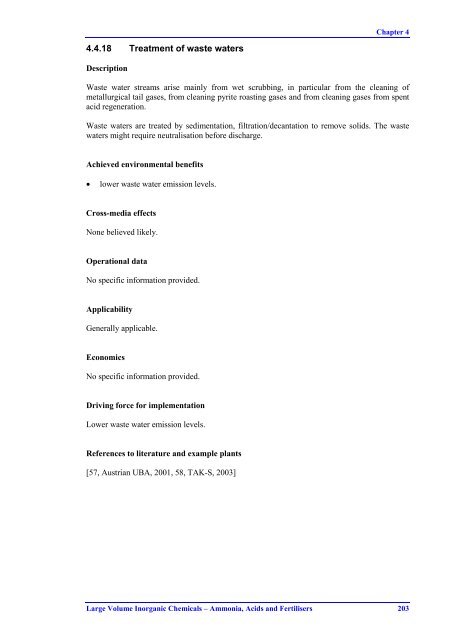Large Volume Inorganic Chemicals - Ammonia ... - ammk-rks.net
Large Volume Inorganic Chemicals - Ammonia ... - ammk-rks.net Large Volume Inorganic Chemicals - Ammonia ... - ammk-rks.net
Chapter 44.4.17 Minimisation of NO x emissionsDescriptionThe formation of NO x has to be considered in the following cases:• burning of sulphur or gases containing sulphur at higher temperatures• decomposition of spent acids• roasting sulphidic ores and pyrite.NO x levels can be minimised by applying low NO x burners.Achieved environmental benefits• for sulphur burning, NO x levels of 20 mg/Nm 3 can be achieved.Cross-media effectsNone believed likely.Operational dataNo specific information provided.ApplicabilityGenerally applicable.EconomicsNo specific data provided.Driving force for implementationLower emissions of NO x and product quality.References to literature and example plants[57, Austrian UBA, 2001]202 Large Volume Inorganic Chemicals – Ammonia, Acids and Fertilisers
Chapter 44.4.18 Treatment of waste watersDescriptionWaste water streams arise mainly from wet scrubbing, in particular from the cleaning ofmetallurgical tail gases, from cleaning pyrite roasting gases and from cleaning gases from spentacid regeneration.Waste waters are treated by sedimentation, filtration/decantation to remove solids. The wastewaters might require neutralisation before discharge.Achieved environmental benefits• lower waste water emission levels.Cross-media effectsNone believed likely.Operational dataNo specific information provided.ApplicabilityGenerally applicable.EconomicsNo specific information provided.Driving force for implementationLower waste water emission levels.References to literature and example plants[57, Austrian UBA, 2001, 58, TAK-S, 2003]Large Volume Inorganic Chemicals – Ammonia, Acids and Fertilisers 203
- Page 180 and 181: Chapter 4Two general converter type
- Page 182 and 183: Chapter 4Figure 4.6 gives an impres
- Page 184 and 185: Chapter 44.2.3 Sulphur sources and
- Page 186 and 187: Chapter 44.2.3.5 Non-ferrous metal
- Page 188 and 189: Chapter 4Sulphur source/SO 2 produc
- Page 190 and 191: Chapter 44.3 Current emission and c
- Page 192 and 193: Chapter 410Tail gas specific SO2 lo
- Page 194 and 195: Chapter 4Capacity in tonnesof 100 %
- Page 196 and 197: Chapter 4Capacity in tonnesof 100 %
- Page 198 and 199: Chapter 4SO 2 sourceSpent acid and
- Page 200 and 201: Chapter 4Cross-media effectsWithout
- Page 202 and 203: Chapter 4Achieved environmental ben
- Page 204 and 205: Chapter 44.4.3 Addition of a 5 th b
- Page 206 and 207: Chapter 44.4.4 Application of a Cs-
- Page 208 and 209: Chapter 4EUR/yearWaste gas volume (
- Page 210 and 211: Chapter 44.4.6 Replacement of brick
- Page 212 and 213: Chapter 4EUR/yearWaste gas volume (
- Page 214 and 215: Chapter 4PlantSO 2 sourceInlet SO 2
- Page 216 and 217: Chapter 44.4.10 Combination of SCR
- Page 218 and 219: Chapter 4Achieved environmental ben
- Page 220 and 221: Chapter 4Driving force for implemen
- Page 222 and 223: Chapter 44.4.14 Monitoring of SO 2
- Page 224 and 225: Chapter 4EconomicsCost benefits can
- Page 226 and 227: Chapter 4Energy inputRecovery and l
- Page 228 and 229: Chapter 44.4.16 Minimisation and ab
- Page 232 and 233: Chapter 44.4.19 Tail gas scrubbing
- Page 234 and 235: Chapter 44.4.21 Tail gas treatment:
- Page 236 and 237: Chapter 4Economics[58, TAK-S, 2003]
- Page 238 and 239: Chapter 4EconomicsNo specific infor
- Page 240 and 241: Chapter 4BAT is to minimise and red
- Page 242 and 243: Chapter 55.2 Applied processes and
- Page 244 and 245: Chapter 55.2.2.1 Raw materials5.2.2
- Page 246 and 247: Chapter 5OriginChinaMine/regionRare
- Page 248 and 249: Chapter 55.2.2.2 GrindingDepending
- Page 250 and 251: Chapter 55.3 Current emission and c
- Page 252 and 253: Chapter 5Emission of mg/l g/tonne P
- Page 254 and 255: Chapter 55.4 Techniques to consider
- Page 256 and 257: Chapter 55.4.2 Hemihydrate process
- Page 258 and 259: Chapter 55.4.3 Hemi-dihydrate recry
- Page 260 and 261: Chapter 55.4.4 Hemi-dihydrate recry
- Page 262 and 263: Chapter 55.4.5 Di-hemihydrate recry
- Page 264 and 265: Chapter 55.4.6 RepulpingDescription
- Page 266 and 267: Chapter 55.4.7 Fluoride recovery an
- Page 268 and 269: Chapter 55.4.8 Recovery and abateme
- Page 270 and 271: Chapter 5Operational dataNo informa
- Page 272 and 273: Chapter 55.4.11 Decadmation of H 3
- Page 274 and 275: Chapter 55.4.12 Use of entrainment
- Page 276 and 277: Chapter 5Cross-media effects• dis
- Page 278 and 279: Chapter 5Driving force for implemen
Chapter 44.4.18 Treatment of waste watersDescriptionWaste water streams arise mainly from wet scrubbing, in particular from the cleaning ofmetallurgical tail gases, from cleaning pyrite roasting gases and from cleaning gases from spentacid regeneration.Waste waters are treated by sedimentation, filtration/decantation to remove solids. The wastewaters might require neutralisation before discharge.Achieved environmental benefits• lower waste water emission levels.Cross-media effectsNone believed likely.Operational dataNo specific information provided.ApplicabilityGenerally applicable.EconomicsNo specific information provided.Driving force for implementationLower waste water emission levels.References to literature and example plants[57, Austrian UBA, 2001, 58, TAK-S, 2003]<strong>Large</strong> <strong>Volume</strong> <strong>Inorganic</strong> <strong>Chemicals</strong> – <strong>Ammonia</strong>, Acids and Fertilisers 203



